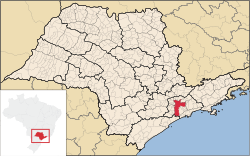 São Paulo (/ˌsaʊ ˈpaʊloʊ/; Portuguese pronunciation: [sɐ̃w ˈpawlu] ( listen); Saint Paul) is a municipality, metropolis and global city located in southeastern Brazil. It is the most populous city in Brazil, in the Americas, in the Western and Southern hemisphere, and the world's thirteenth largest city by population. The metropolis is anchor to the São Paulo metropolitan area, ranked as the most populous metropolitan area in Brazil, the second in the Americas and the seventh in the world.[2] São Paulo is the capital of the state of São Paulo, Brazil's most populous and wealthiest state. It exerts strong regional influence in commerce, finance, arts and entertainment and a strong international influence.[3] The name of the city honors Saint Paul of Tarsus.
São Paulo (/ˌsaʊ ˈpaʊloʊ/; Portuguese pronunciation: [sɐ̃w ˈpawlu] ( listen); Saint Paul) is a municipality, metropolis and global city located in southeastern Brazil. It is the most populous city in Brazil, in the Americas, in the Western and Southern hemisphere, and the world's thirteenth largest city by population. The metropolis is anchor to the São Paulo metropolitan area, ranked as the most populous metropolitan area in Brazil, the second in the Americas and the seventh in the world.[2] São Paulo is the capital of the state of São Paulo, Brazil's most populous and wealthiest state. It exerts strong regional influence in commerce, finance, arts and entertainment and a strong international influence.[3] The name of the city honors Saint Paul of Tarsus.
maps are also distinct for the global knowledge required to construct them. A meaningful map of the world could not be constructed before the European Renaissance because less than half of the earth's coastlines, let alone its interior regions, were known to any culture. New knowledge of the earth's surface has been accumulating ever since and continues to this day. Maps of the world generally focus either on political features or on physical features. Political maps emphasize territorial boundaries and human settlement. Physical maps show geographic features such as mountains, soil type or land use. Geological maps show not only the surface, but characteristics of the underlying rock, fault lines, and subsurface structures. Choropleth maps use color hue and intensity to contrast differences between regions, such as demographic or economic statistics.
Tuesday, August 4, 2015
Saopaulo Map
2:45 PM
Maps
 São Paulo (/ˌsaʊ ˈpaʊloʊ/; Portuguese pronunciation: [sɐ̃w ˈpawlu] ( listen); Saint Paul) is a municipality, metropolis and global city located in southeastern Brazil. It is the most populous city in Brazil, in the Americas, in the Western and Southern hemisphere, and the world's thirteenth largest city by population. The metropolis is anchor to the São Paulo metropolitan area, ranked as the most populous metropolitan area in Brazil, the second in the Americas and the seventh in the world.[2] São Paulo is the capital of the state of São Paulo, Brazil's most populous and wealthiest state. It exerts strong regional influence in commerce, finance, arts and entertainment and a strong international influence.[3] The name of the city honors Saint Paul of Tarsus.
São Paulo (/ˌsaʊ ˈpaʊloʊ/; Portuguese pronunciation: [sɐ̃w ˈpawlu] ( listen); Saint Paul) is a municipality, metropolis and global city located in southeastern Brazil. It is the most populous city in Brazil, in the Americas, in the Western and Southern hemisphere, and the world's thirteenth largest city by population. The metropolis is anchor to the São Paulo metropolitan area, ranked as the most populous metropolitan area in Brazil, the second in the Americas and the seventh in the world.[2] São Paulo is the capital of the state of São Paulo, Brazil's most populous and wealthiest state. It exerts strong regional influence in commerce, finance, arts and entertainment and a strong international influence.[3] The name of the city honors Saint Paul of Tarsus.




